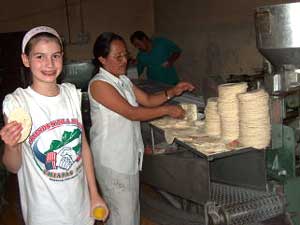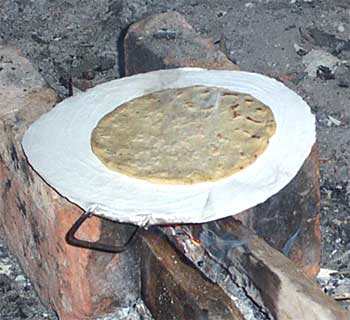

 Photo by Lanita Medina of Maine
Photo by Lanita Medina of MaineTortillas are being made whenever you're in almost any Mexican Indian village, it's around dawn, or a little before, you smell wood smoke, and you hear patting sounds coming from all directions. It sounds like multitudes of people rapidly slapping their fat stomachs. This is the sound of women forming masa into corn tortillas, by patting them with their hands. Tortillas lie at the very heart of Mexican soul-food.
Most Mexican tortillas are pale, cream-white, flat, thin (about 1/16-inch thick), circular disks about six inches in diameter. If the masa from which they are prepared comes from nixtamal made with blue corn -- very common in parts of upland Mexico -- they'll be bluish. Once masa is shaped into tortillas, the tortillas are baked on a dry (no oil or grease) hot-plate usually referred to as a comal. Ideally, tortillas are eaten hot off the comal, or else deposited in a little straw canister covered with a cloth and resting on the table next to the person eating. As tortillas are removed from the canister for eating, new ones are added.
 Hot tortillas right off the machine. Notice the large bulk of masa, or corn-paste, on the right. Photo by Lanita Medina of Maine
Hot tortillas right off the machine. Notice the large bulk of masa, or corn-paste, on the right. Photo by Lanita Medina of MaineTortillas are Mexico's "basic bread." It's impossible for most Mexicans to visualize any meal as being complete without them. In and around mercados, tortilla-making establishments called tortillarías, such as the one at the right, can often be located by the squeaking and roaring sounds of the dragonlike, Rube- Goldbergian, tortilla-spitting-out, metal contraption occupying most of the tortillaría's space. The squeaking comes from all the moving metal parts that accept great bulks of moist masa in one place and then dispense hot, finished tortillas elsewhere; the roaring comes from gas burners roasting the tortillas as they are conveyed through the metal monstrosity on a belt. In the photograph, note the tall pile of tortillas on the scale, and the big lump of masa to the scale's right.
 Buying tortillas in Tepotzlan, Morelos. Image by Keith Baines of Jersey City, NJ
Buying tortillas in Tepotzlan, Morelos. Image by Keith Baines of Jersey City, NJYou should know about the great war currently being fought in Mexico between corn and wheat tortillas. Wheat arrived in Mexico with the Spaniards. Thus, in the Mexican mind, wheat has always been associated with European (and later, North American) culture, while corn has remained associated with Mexico's indigenous roots. Some people further unfortunately and unjustifiably associate wheat with social advancement, while corn represents tradition, or "backwardness." In Mexico's most "Americanized" region, in the North and in Baja California, wheat-flour tortillas probably surpass corn tortillas in importance. Wheat tortillas are made with pig lard or vegetable oil at a proportion of one-eighth part lard or oil to each part of wheat flour.
Therefore, in some circles today the choice of whether one eats wheat or corn tortillas amounts to nothing less than a declaration of which set of values -- traditional Mexican or "modern" -- the eater aspires to. This is unfortunate, because corn tortillas are much more nutritious and tasty than wheat ones, despite the fact that those bland, pasty, colorless wheat tortillas, often sold in plastic bags, are making tremendous inroads as Mexican society evolves. Today many Mexicans have even changed to sliced, wheat-based white bread of the kind we tolerate in North America. The main Mexican white-bread is appropriately called Pan Bimbo -- Bimbo Bread.
 The perfect tortilla, handmade of corn masa, heating on a metal comal
The perfect tortilla, handmade of corn masa, heating on a metal comalIt might seem that, with so few ingredients and such simple preparation, the world of the tortilla would be a tedious one. Not so. For example, real tortilla connoisseurs grind their masa twice to achieve finer texture. Standard traditional tortillas are made from masa softened with water. Instead of water, lard or vegetable oil can be used, or even sour milk, or whey and salt. Maybe the finest tortillas of all can sometimes be found in the mountains of Hidalgo, where tortillas called chavacanes, or hojarascas, are formed from very fine masa patted into paper-thin, salted quadrangles. These are baked like regular tortillas and then slightly toasted. When eaten, they melt in the mouth. On the other hand, in Guerrero, sometimes they make rough corn tortillas not taken through the entire nixtamal/masa process; these are called toqueras.
Some tortilla recipes are so innovative that what results is only arguably a tortilla. In the Isthmus of Tehuantepec and around Oaxaca, a kind of giant tortilla called a totopo is constructed ten to fourteen inches in diameter. To keep it from distorting during baking, each totopo is poked with a finger or other object, indenting the faces. Toasted totopos can be stored a long time beforesouring.
 Jícara gourd keeping tortillas warm
Jícara gourd keeping tortillas warm